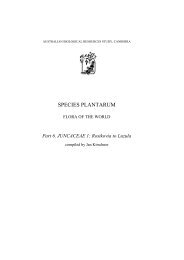Introduction - Species Plantarum Programme
Introduction - Species Plantarum Programme
Introduction - Species Plantarum Programme
Create successful ePaper yourself
Turn your PDF publications into a flip-book with our unique Google optimized e-Paper software.
Chromosome numbers<br />
26<br />
SPECIES PLANTARUM — FLORA OF THE WORLD (1999)<br />
Chromosome counts based on reliably identified material should be included, and run on<br />
from the last line of the description. They should be cited in the form given in the original<br />
source together with the reference, e.g. x = 12, B.A.Barlow & D.Wiens, Taxon 20: 291<br />
(1971).<br />
Common names<br />
Common names are in general not cited. In the case of plants of major economic importance,<br />
the English name may be indicated in the Further Notes paragraph, e.g. under Solanum<br />
tuberosum the name 'potato' should be indicated in the comments.<br />
Citation of <strong>Species</strong> <strong>Plantarum</strong> figures<br />
Reference to a figure to be included in <strong>Species</strong> <strong>Plantarum</strong> goes at the end of the descriptive<br />
paragraph as Fig. ***, the number being added later by the Executive Editor. Line drawings<br />
and colour plates are all termed Figures, e.g. in Anthocercis littorea, Fig. 4 is a colour plate<br />
and Fig. 5A, B is a black-and-white illustration (Fl. Australia 29: 9, 1982).<br />
<strong>Species</strong> distribution and habitat<br />
The paragraph after the species description describes the distribution and habitat of the<br />
species in a world context. First the distribution is described in free text in terms of specific<br />
geographical localities or features, together with the country or countries. This is followed<br />
by a coded list of 'botanical countries', as listed in S.Hollis & R.K.Brummitt, World<br />
Geographical Scheme for Recording Plant Distributions (Hunt Institute for Botanical<br />
Documentation, Pittsburgh, 1992). Only the Level 2 and 3 units are used. These should be<br />
listed with the 2-digit code indicating continent and region, followed by a colon, and the 3letter<br />
code for each 'country', separated by commas. Where a species occurs in each 'country'<br />
of a region, the designation 'All'. may be used. If a taxon is present in a 'country' only as an<br />
introduced or naturalised plant, then the 'country' is given in lower case letters. If a taxon<br />
was previously present in a 'country' but is now extinct there, the 'country' is given in upper<br />
case letters followed by a dagger. Distribution as a cultivated plant is not listed<br />
New South Wales: Between Broken Hill and Orange. 50: NSW.<br />
New South Wales to Queensland: From Bundaberg, Queensland, S to Newcastle, New South<br />
Wales, within 50 km of the coast. 50: NSW, QLD.<br />
Native to central South America, but naturalised widely in tropical, subtropical and warm<br />
temperate countries worldwide. 10: grb. 11: aut. 12: fra. 26: zim. 27: bot, cpp, les, nat, ofs,<br />
swz, tvl. 29: mdg. 38 jap. 42: jaw, mly, phi. 50: nsw, qld, tas, vic. 51: nzn. 63: haw. 76: arl,<br />
cal, nev, uta. 77: tex. 78: ala, fla, geo, lou, msi. 83: BOL. 84: BZC. 85: AGE, AGW, CLN,<br />
PAR, URU.<br />
Well-known regional names may be used in the free text description, e.g. Cape York<br />
Peninsula, Sahara Desert, Rocky Mountains, but not local names such as North Kennedy or<br />
South West Slopes. Distribution must be based on herbarium collections. The free text<br />
description of distribution should use geographical in preference to political terms, e.g.<br />
tropical Africa, SE Asia.<br />
The habitat is then described. It may be given in the same sentence as the distribution,<br />
following a semi-colon; or it may be in a separate sentence in the same paragraph. The soil,












